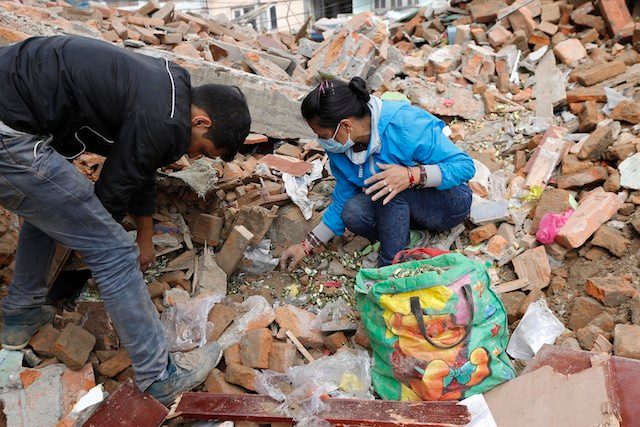SUMMARY
This is AI generated summarization, which may have errors. For context, always refer to the full article.

KATHMANDU, Nepal – Nepalese riot police battled Wednesday, April 29, to contain anger among survivors of an earthquake that killed more than 5,000 people as rescuers raced against time to find anyone else alive in the rubble of the capital Kathmandu.
Supplies are running thin and aftershocks have strained nerves in the ruined city. Desperate to leave, thousands of people began gathering from before dawn outside the main bus station after the government promised to lay on special services.
But when the buses failed to materialize, anger began surging and scuffles broke out between the crowds and the columns of riot police who were sent in to try to contain the situation near parliament.
“We have been waiting since dawn. They told us that there would be 250 buses coming but we haven’t seen any of them,” said Kishor Kavre, a 25-year-old student.
“We’re in a hurry to get home to see our families but we’ve no idea when they’re coming now. I think the government is struggling.”
There was also desperation in devastated rural areas where people have been pleading to be airlifted out when the occasional helicopter has reached their villages with relief supplies.
A total of 5,057 people are so far known to have died in Nepal alone from Saturday’s quake, and around 100 more in neighboring India and China.
Around 8,000 were injured while the United Nations estimates that 8 million people have been affected by Nepal’s worst natural disaster in 8 decades.
Among the dead were 18 climbers who were at Mount Everest base camp when an avalanche from the quake flattened everything in its path. The victims included two Americans, an Australian and a Chinese national.
Although the aftershocks have begun to subside, hundreds of thousands of people were still sleeping outside in the streets as their homes had either been wrecked or were feared to be on the verge of collapse.
Rescued after 82 hours
Rescue teams from a large number of countries are helping the hard-pressed authorities in one of Asia’s poorest nations.
French rescuers managed to pluck one man from the rubble of his Kathmandu home late on Tuesday, April 28, after he was trapped under masonry for around 82 hours.
Barely conscious and covered in dust, 27-year-old Rishi Khanal was taken to hospital in an ambulance after being fitted with a neck brace and having a drip attached to his right arm.
But rescuers underlined the daunting scale of the task.
“It’s a very difficult disaster zone, very compact and on top of that it’s been raining,” Pascal Montant, part of the French rescue team, told Agence France-Presse after one fruitless search of wreckage.
“When I took my dog off the leash it didn’t give out any signal, it didn’t bark, which means that possibly there’s no one inside.”
In Gorkha, one of the worst-hit districts, terrified residents ran with outstretched arms towards an Indian army helicopter to plead for food and water.
An Agence France-Presse journalist on board saw scores of houses across several villages in the district reduced to mounds of wood and corrugated tin roofs.
“We haven’t had any food here since the earthquake. Everything has changed, we don’t have anything left here,” Sita Gurung told Agence France-Presse, gesturing towards what was left of her home in the village of Lapu.
An army officer lifted her onto a stretcher and carried her away.
Resources stretched
The Nepalese army said that an improvement in the weather should help efforts to reach rural areas.
“We are moving forward with intensive rescue operations today,” said Nepalese army spokesman Jagdish Pokharel.
“We are stretching our resources to reach out to as many areas as possible. The weather today has improved so we hope to help more victims today. Helicopters have been deployed to bring the injured to hospital.”
An army helicopter reached the scene of an avalanche in the Ghoratabela district on Tuesday afternoon in a region that is popular with foreign trekkers.
The scale of casualties was unknown but 18 survivors had been rescued and there were believed to be 200-250 people in the area, said Gautam Rimal, a senior local official.
Nepal’s only international airport on the outskirts of Kathmandu has been operating round-the-clock to accommodate the arrival of military planes carrying aid.
Among the arrivals was a British RAF C-17 flight that was bringing 1,100 shelter kits and over 1,700 solar lanterns, along with a team of Gurkha engineers – the famed army unit that hails from Nepal.
The quake is a serious blow to the economy of the impoverished nation, already reeling from a decade-long civil war that ended in 2006, with one estimate putting the cost of reconstruction at $5 billion. – Claire Cozens, AFP / Rappler.com
Add a comment
How does this make you feel?
There are no comments yet. Add your comment to start the conversation.